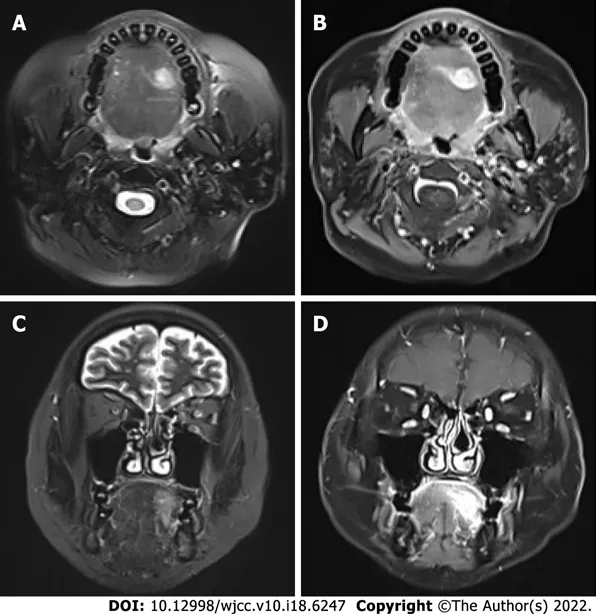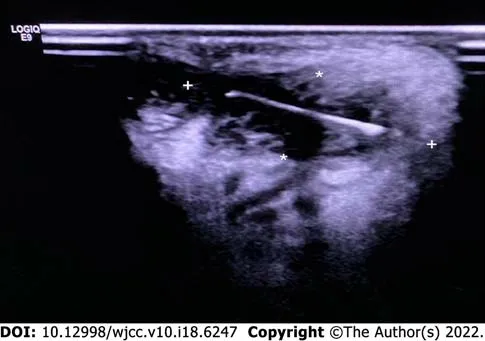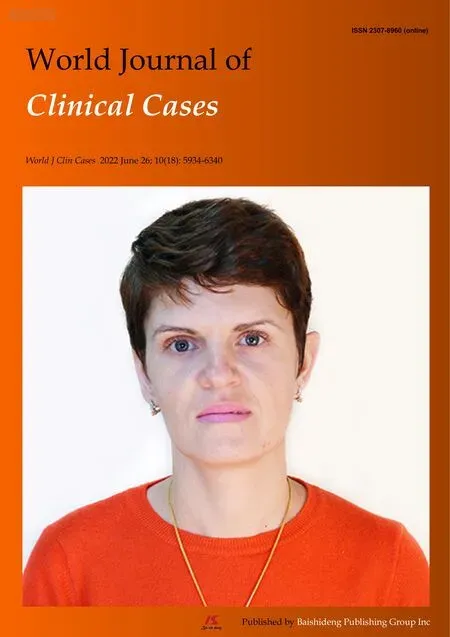Foreign body granuloma in the tongue differentiated from tongue cancer: A case report
lNTRODUCTlON
The introduction of a foreign body into the tongue can occasionally occur as food is being chewed. In most situations this can lead to pain, swelling and irritation[1]. Such foreign bodies can usually be identified and diagnosedvisual inspection, especially if they are not buried in the muscle layer[2]. A clear history of foreign body introduction into the mouth, as well as a timely visit to the physician, can be conducive to the diagnosis[3]. Penetration of the tongue by a foreign substance can cause an acute inflammatory response and foreign bodies that remain in place may elicit a granulomatous inflammatory response[4]. The cause of granuloma in the tongue can be difficult to ascertain, especially without a clear history of foreign body ingestion. In this paper, we describe the case of a foreign body granuloma in the tongue of a Chinese woman. The initial diagnosis was tongue cancer but further examination revealed a foreign body in the tongue which was removedsurgery.
艾莉沒有見到戴菲兒的合格證、發票、信譽卡、保修卡、使用說明……但她相信戴菲兒所說的每一句話。因為哀傷無法掩飾。因為她看到戴菲兒的哀傷,秦川的哀傷。她聽到連接在他們之間的那根看不見的細細的線繩的崩斷之音。一頓飯的時間,她成為主人,戴菲兒成為玩偶,世界就是這般離奇,充滿變數。
另外,進口品最大的問題在于受制于進口備案等一系列手續。不過,隨著跨境電商的發展,韓妝也成為受惠者之一。例如,近日阿里巴巴宣布與浙江自貿區達成合作,加快非特殊化妝品備案流程,幫助進口化妝品同步進入中國市場。未來,通過阿里巴巴統一備案的普通進口化妝品,從注冊備案到獲批周期大幅加快至3個月內。
CASE PRESENTATlON
Chief complaints
The patient recovered well and there were no complications during the 2-mo follow-up period.
History of present illness
The patient sought out a general practitioner because of pain and noticeable swelling in the tongue that persisted for over 1 mo. She was given a short course of antibiotics which provided no symptom relief.The patient was referred to the Department of Stomatology, where an oral surgeon prescribed oral maxillofacial magnetic resonance imaging (MRI). The imaging revealed abnormal signal intensities, as shown in Figure 1, which are indicative of tongue cancer. The patient then visited the ENT Department for further consultation.
The results of routine tests of complete blood count, kidney function and liver function were normal.
History of past illness
本世紀以來,兒童參與武裝沖突的問題引起國際社會越來越多的關注,市場和互聯網上涌現的大量自傳、新聞報道、紀錄片、小說和電影表明媒體和藝術在共同努力讓世界了解此問題。參與武裝沖突的兒童多是被綁架的兒童,年齡一般在5~18歲,他們被迫接受殘酷的訓練,被迫參與殺人劫掠行動,這些兒童被稱為娃娃兵(child soldier)。在哥倫比亞、斯里蘭卡、阿富汗、伊拉克以及非洲的一些國家,如幾內亞、象牙海岸、利比里亞、塞拉利昂、烏干達等娃娃兵問題非常嚴重。聯合國兒童基金會(UNICEF)等國際組織一直都在盡力解救娃娃兵,并努力幫助解救出的娃娃兵以健康的心理回歸社會。
2.圍繞提升專業能力素質構建專業支撐課程。支撐課程是對學員專業能力素質起基礎和支撐作用的課程,對打牢學員的學科專業基礎、掌握扎實的專業理論知識,提高對部隊裝備和訓練變換的適應能力有著重要作用。對于這類課程的定位,要充分考慮部隊任職崗位及未來崗位變化對學員專業能力的要求。既要注重讓學員掌握寬厚的專業基礎知識,又兼顧讓學員掌握專業技術學習和訓練的基本方法,形成知識遷移和自主學習的能力,為學員的后續發展進行知識儲備。
Personal and family history
There was no specific personal and family history.
Physical examination
Intraoral examination showed mild swelling in a longitudinal 2 cm × 1.5 cm area on the left lateral aspect of the tongue. A hardened nodule with an ill-defined margin was found on the tongue. The nodule was the same color as the surrounding tongue tissue (normal color) and no clearly identifiable foreign bodies were observed on the tongue as shown in Figure 2.

Laboratory examinations
在其2013年3月發表的“美國小學數學結構之批評”一文中,馬立平博士用下圖比較了傳統數學(左)和發現式數學(右)在內容和結構上的差異[7]:
Imaging examinations
The oral maxillofacial MRI showed abnormal and ill-defined signal intensities on the left side of the tongue (size: 1.6 cm × 1.2 cm × 2.0 cm; Figure 1) and multiple swollen cervical lymph nodes (up to 0.7 cm in size, in the submaxillary region and carotid sheath). The primary diagnosis was tongue cancer as reported by the specialists in the Department of Radiology. However, the doctors in the ENT Department reviewed the MRI images and considered the possibility of foreign body granuloma for two reasons. First, granuloma and cancer can have similar imaging features; and second, the shadow seemed to indicate that the tongue tissue was protected from foreign bodies, as shown by images taken in the transverse plane. During the initial clinical interview the patient denied a history of foreign body ingestion. To differentiate between the two possibilities, further examinations were conducted.
Further diagnostic work-up
Informed written consent was obtained from the patient for publication of this report and any accompany images.



FlNAL DlAGNOSlS
Foreign body (fish bone) granuloma in the tongue.
TREATMENT
After the surgery, the patient received antibiotics (ceftriaxone) with systemic steroids and the postoperative recovery was uneventful. The patient was discharged on the third post-operative day.
OUTCOME AND FOLLOW-UP
A 61-year-old woman was admitted to the Ear Nose and Throat (ENT) Department of our hospital complaining of pain and noticeable swelling of the tongue.
DlSCUSSlON
A diagnosis of tongue cancer is often considered in older adults with an enlarged tongue nodule/mass and localized pain[5]. The many differential diagnoses of a tongue mass include an inflammatory lesion and schwannoma[1]. A diagnosis of a granuloma attributable to an embedded foreign body is rare when there is no clear history of foreign body ingestion or oral trauma[6]. In the present case, the differential diagnosis of an irregular nodule with a smooth surface included cavernous hemangioma, anaplastic large-cell lymphoma, endophytic squamous cell carcinoma and Kaposi sarcoma of the tongue[7-10].Differential diagnosis is important as cancer treatment and enucleation of a foreign body granuloma differ greatly in terms of surgical preparation, operation, tongue reconstruction and patient consultation[11-13].
The patient had no previous medical history.
MRI is the preferred diagnostic modality for evaluating tongue cancer because abnormal MRI signals have been strongly associated with pathological findings[14]. However, MRI is not an ideal modality for differentiating tongue cancer from embedded foreign body granuloma with foreign body[15]. The signals associated with tongue cancer are hyperintensity in a T2-weighted image (WI) and heterogeneous enhancement in an enhanced T1 WI, similar to granuloma[14,16]. In the present case, the fish bone (shown by hypointense signals in both the T1 and T2 WIs) was difficult to detect by MRI[17], and not surprisingly the primary diagnosis of tongue cancer was consistent with the abnormalities found in the tongue by MRI and with the swollen cervical lymph nodes. Besides this, shifting of metal fragments under the effects of MRI can result in potential damage of vital structures. If the doubt of a metal foreign body is present, the contraindications of MRI should be considered[18].
Several studies used ultrasound to detect a suspected embedded foreign body in the tongue[3,4,6].The foreign bodies, which included a pequi spine, metal wire, and fish bone were visualized and localized accurately, demonstrating the utility of ultrasound for guiding therapeutic interventions.Multislice computerized tomography (CT) and cone beam CT also seem useful for visualizing embedded foreign bodies, although CTs have poor performance in terms of detecting wood[15]. Thus,when an embedded foreign body is suspected in a patient with an enlarged tongue mass, ultrasonography and CT can play an important role in the differential diagnosis[19].
In our case, the lesion was “walled off” on transverse images (Figure 2). This might indicate that the mass was “delimited” by a capsule. A similar sign was observed in an early case report of a patient with foreign body granuloma[16]. Thus, this sign might be a useful indicator of the need for further examinations (other than MRI). However, this issue requires further investigation.
CONCLUSlON
We reported the case of a woman with an enlarged tongue mass initially diagnosed with tongue cancer.The ENT specialists reviewed the MRI data and corrected the diagnosis to ‘foreign body in the tongue’based on oral ultrasound examination. The granuloma containing the fish bone was completely removed during surgery and post-operative pathological examination confirmed that the lesion was a granuloma. In cases with an enlarged tongue mass, oral ultrasound and/or CT examinations are important for differential diagnosis, to facilitate selection of the appropriate treatment method.
ACKNOWLEDGEMENTS
the Research Start-up Grant for Talent of Mianyang Central Hospital of China, No. 2021YJRC-001; and the Applied Technique Research and Development Program of Mianyang City of China, No. 2019YFZJ022.
FOOTNOTES
Xu R was the patient’s doctor in charge, reviewed the literature and contributed to manuscript drafting; Jiang ZH operated on the patient and contributed to manuscript drafting; Xia L reviewed the literature and was responsible for the revision of the manuscript for important intellectual content; All authors issued final approval for the version to be submitted.
The authors acknowledge the colleagues for participating in this study. We are deeply indebted to the patient who participated in this study.
The patient was referred for ultrasound examination of the tongue. The ultrasound device used a linear probe with a 13-MHz transducer. The acoustic picture was consistent with a linear hyperechoic foreign body, specifically a piece of bone, as shown in Figure 3. When asked about the possibility of fish bone ingestion or another foreign body in the tongue, the patient could not recall whether she had recently eaten fish. However, her daughter recalled that a meal containing fish (with bones) might have been served to the patient 2 mo prior to seeking medical assistance. Complete surgical enucleation of the lesion was then conducted. The mass with the fish bone was completely removed without compromising the capsule (Figure 4A), and no hemorrhagic accident occurred. The fish bone was 1.5 cm in length (Figure 4B). Post-operative pathological examination showed that the lesion was a granuloma containing collagen fibers, macrophages and chronic inflammatory cells.
The authors declare that they have no conflict of interest.
丁苯酞聯合阿替普酶對急性腦梗死患者神經功能、認知功能和Hcy等血清學指標的影響 ……………… 朱 燁等(8):1095
The authors have read the CARE Checklist (2016), and the manuscript was prepared and revised according to the CARE Checklist (2016).
This article is an open-access article that was selected by an in-house editor and fully peer-reviewed by external reviewers. It is distributed in accordance with the Creative Commons Attribution NonCommercial (CC BYNC 4.0) license, which permits others to distribute, remix, adapt, build upon this work non-commercially, and license their derivative works on different terms, provided the original work is properly cited and the use is noncommercial. See: https://creativecommons.org/Licenses/by-nc/4.0/
阿東說:“蠻好。我姆媽原先每天七點半叫阿里起來,現在叫他提前起。把錄音機帶著,到東湖邊去放哀樂。那里沒有什么人,放多大聲音都不怕。”
China
Zhen-Hua Jiang 0000-0001-5239-9154; Ran Xv 0000-0002-5381-111X; Li Xia 0000-0002-5529-884X.
以貫徹落實黨的十八大精神為起點,順應時代發展,回應民生訴求,在全市范圍全面實施“水更清”行動計劃,水生態文明建設再譜新篇章。
Ma YJ
Filipodia
Ma YJ
 World Journal of Clinical Cases2022年18期
World Journal of Clinical Cases2022年18期
- World Journal of Clinical Cases的其它文章
- Stem cells as an option for the treatment of COVID-19
- Development of clustered regularly interspaced short palindromic repeats/CRISPR-associated technology for potential clinical applications
- Prostate sclerosing adenopathy: A clinicopathological and immunohistochemical study of twelve patients
- Effectiveness and postoperative rehabilitation of one-stage combined anterior-posterior surgery for severe thoracolumbar fractures with spinal cord injury
- Construction and validation of a novel prediction system for detection of overall survival in lung cancer patients
- Identification of potential key molecules and signaling pathways for psoriasis based on weighted gene coexpression network analysis
